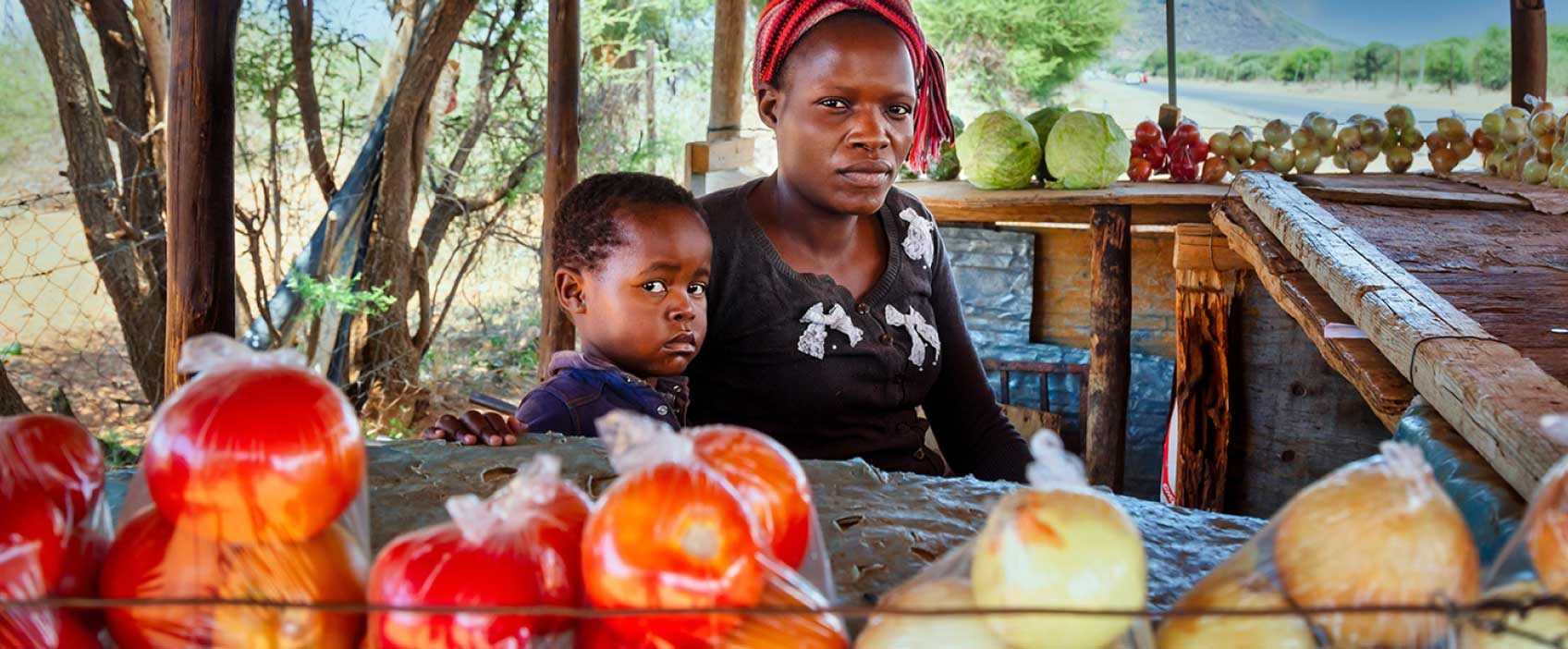
Publications and Datasets
IFPRI publications provide evidence-based insights and analysis on critical issues related to policies for food systems, food security, agriculture, diets and nutrition, poverty, and sustainability, helping to inform effective policies and strategies. Materials published by IFPRI are released under a Creative Commons license, and are available for download. IFPRI authors also publish in external sources, such as academic journals and books. Where possible we provide a download link for the full text of these publications.
Featured Publications
Journal Article
To defer or to differ: Experimental evidence on the role of cash transfers in Nigerian couples’ decision–making
2025Bakhtiar, M. Mehrab; Fafchamps, Marcel; Goldstein, Markus; Leonard, Kenneth L.; Papineni, SreelakshmiOpinion Piece
Redefining health priorities: Sub-Saharan Africa’s new frontier in disease burden
2024Zerfu, Taddese Alemu; Tareke, Amare A.; Biadgilign, SibhatuJournal Article
Methods for estimating beneficiary populations targeted by health and nutrition interventions for women, pregnant women, infants, and young children
2025Gune, Soyra; Nguyen, Phuong Hong; Chakrabarti, SumanExplore Our Latest Publications
By Title By Author By Country/Region By Keyword
Journal Article
Whole maize flour could enhance food and nutrition security in Malawi
Journal Article
Rural institutions and the technical efficiency of teff production in Ethiopia
Journal Article
Assessing the overall benefits of programs enhancing human capital and equity: A new method with an application to school meals
Journal Article
Potential decarbonization for balancing local and non-local perishable food supply in megacities
Journal Article
Front-of-pack labels and young consumers: An experimental investigation of nutrition and sustainability claims in Chile
Journal Article
Storage management practices and mycotoxin contamination of sorghum (Sorghum bicolor) in northwest Ethiopia
Journal Article
Global shocks to fertilizer markets: Impacts on prices, demand and farm profitability
Journal Article
Maize yield responsiveness and profitability of fertilizer: New survey evidence from six African countries
Journal Article
Fertilizer demand and profitability amid global fuel-food-fertilizer crisis: Evidence from Ethiopia
Journal Article
Estimating the direct and indirect effects of improved seed adoption on yields: Evidence from DNA-fingerprinting, crop cuts, and self-reporting in Ethiopia
Journal Article
Fertilizer policy reforms in the midst of crisis: Evidence from Rwanda
Journal Article
Inclusive and gender-transformative seed systems: Concepts and applications
Journal Article
Fertilizer and conflicts: Evidence from Myanmar
Brief
Uganda: Systematic analysis of world market and domestic production shocks
Brief
Ghana: Systematic analysis of world market and domestic production shocks
Working Paper
Detecting cumulative effects of inputs within the flexible production function framework through LASSO shrinkage estimation: Implications for potassium fertilizer use in India
Working Paper
Business aspects along the rural-urban continuum, outlet type, and gender of ownership among MSMEs in the Vietnamese food environment
Report
IFPRI strategy for engagement with CAADP 2026-2035: Supporting implementation at regional, sub-regional, and national levels
Brief
IFPRI-Sudan: Generating evidence-based solutions for strengthening humanitarian response and economic resilience
Journal Article
The full lethal impact of massive cuts to international food aid
Brief
Sudan Strategy Support Program (SSSP): Background and research output
Journal Article
Adapting the Women’s Empowerment in Nutrition Index: Lessons from Kenya
Journal Article
Dataset on the patterns of livelihood diversification in farming systems of the Eastern Gangetic Plains of South Asia
…more
Karki, Emma; Thapa, Kali Rattan; Rana, Gunjan; Kishore, AvinashJournal Article
Adoption or placement in foster care and catch-up in linear growth and development: A meta-analysis of individual participant data
Journal Article
The costs of a multisectoral nutrition program implemented through a poultry value chain platform in Burkina Faso
Journal Article
Impacts of city life on nutrition: Evidence From resettlement lotteries in China
Journal Article
The unmet financial needs of intermediary firms within agri-food value chains in Uganda and Bangladesh
Journal Article
Evolution of intimate partner violence impacts from cash transfers, food transfers, and behaviour change communication: Mixed-method experimental evidence from a nine-year post-programme follow-up in Bangladesh
Journal Article
Research priorities for drivers of food choice for food system transformation in South Asia: Proceedings of a collaborative workshop
Journal Article
Weather shocks and rice (Oryza sativa) yield response to fertilizer: Representative field-level evidence from Bangladesh
Journal Article
Sustainable poverty reduction through social assistance: Modality, context, and complementary programming in Bangladesh
Brief
Egypt: Systematic analysis of world market and domestic production shocks
Brief
Synopsis: Commercialization and dietary diversity of Rwandan smallholder farmers: a focus on women and youth headed households
Infographic
Does Ukraine need a new Black Sea Grain Initiative?
Working Paper
Guilty pleasures: Expenditure elasticities of ultra-processed foods and paid meals in India
Brief
Aid budget cuts have dire consequences for malnutrition among the world’s most vulnerable children
…more
Haddad, Lawrence; Ho, Melissa; Loboguerrero Rodriguez, Ana María; Zougamoré, RobertJournal Article
Intensive and extensive margins of India’s agricultural trade: implications for export diversification and development
Working Paper
The impact of the African continental Free Trade Agreement: A continentwide macroeconomic assessment and distributional analysis in Nigeria and Rwanda
Brief
Synopsis: The dynamic impact of alternative livestock sector interventions and spending options in Rwanda
Dataset
SELEVER study: Endline survey
Dataset
SELEVER study: Baseline survey
Dataset
SELEVER study: Second follow-up survey
Dataset
SELEVER study: First follow-up survey
Opinion Piece
The double burden of food and water insecurity: Implications for health, equality, and policy
Journal Article
Farmers’ pesticide use, disposal behavior, and pre-harvest interval: A case study from Nigeria
Book
Contract Farming in Developing Countries: The promise and its perils
Working Paper
Tajikistan’s agrifood system: The past performance and future opportunities and challenges
Dataset
Papua New Guinea Rural Household Survey, 2023
Brief
Preferences for ecosystem payment programs in Papua New Guinea
Journal Article
Imperfect competition and asymmetric welfare effects of global price and productivity shocks: a CGE model analysis for Senegal
Report
IFPRI Malawi monthly maize market report, February 2025
Working Paper
Under the gun: Military and paramilitary actors in Sudan’s agri-food system
Conference Proceedings
Report on state-level training programme for FPOs in Odisha
Journal Article
Co-occurrence of stunting and off-track early child development in low- and middle-income countries
Journal Article
Quality of routine health and nutrition data in Ethiopia: A systematic review
Journal Article
Armed conflict and gendered participation in agrifood systems: Survey evidence from 29 African countries
Journal Article
Building Ethiopia’s food security resilience to climate and hydrological change
Journal Article
Perspective: Can growth monitoring and promotion accurately diagnose or screen for inadequate growth of individual children? A critical review of the epidemiological foundations
Journal Article
Risk-appropriate, science-based innovation regulations are important
Journal Article
Protocol: Food environment, food choice, diets, and nutrition outcomes of pastoralists in Africa: Scoping review protocol
Journal Article
Global analysis reveals persistent shortfalls and regional differences in availability of foods needed for health
Journal Article
Shocks and stability of risk and time preferences among poor rural households in Ethiopia
Journal Article
Impact of farm size on the function of landscape-level payments for ecosystem services: An agent-based model study
Journal Article
Rural underemployment and urbanisation: Insights from a 9-year panel from Malawi
Journal Article
Wholesalers and the transformation of Myanmar’s maize value chains
Journal Article
Evaluating the gendered credit constraints and uptake of an insurance-linked credit product among smallholder farmers in Kenya
Journal Article
Health or economics: Unpacking concern type and severity in the COVID-19 pandemic
Journal Article
Adapting to extreme weather conditions in a developing country: An economywide policy assessment from Malawi
Journal Article
Understanding pastoralist adaptations to drought via games and choice experiments: Field testing among Borana communities
Brief
Papua New Guinea: Systematic analysis of domestic production and world market shocks
Journal Article
Employment impacts of agrifood system innovations and policies: A review of the evidence
Brief
Climate change and the impact on taro in Papua New Guinea
Journal Article
A band selection method for consumer-grade camera modification for UAV-based rapeseed growth monitoring
…more
Wen, PingJournal Article
Comparison of gestational age assessment methods in the second and third trimesters: Evaluating alternative approaches against ultrasound in urban Burkina Faso
…more
Huybregts, Lieven; Hadush, Kokeb Tesfamariam; Lachat, Carl; Toe, Laeticia Celine; Dailey-Chwalibóg, TrentonAbstract
South Asia Nutrition Knowledge Initiative: Abstract digest March 2025
Working Paper
Production and consumption traits and the adoption of improved maize varieties: Evidence from seed sample packs and cooking demonstrations
Report
Experiential learning tools for sustainable water management [India]
Journal Article
Nurturing care in the first 10 years of life: Results from a Vietnamese longitudinal study
Journal Article
Ex ante economic impact assessment of the 3R-gene potato in Kenya
Working Paper
Seeds of change: The impact of Ethiopia’s direct seed marketing approach on smallholders’ seed purchases and productivity
Journal Article
Maternal balanced energy-protein supplementation reshapes the maternal gut microbiome and enhances carbohydrate metabolism in infants: A randomized controlled trial
…more
Hanley-Cook, Giles T.; Ouédraogo, Moctar; Ganaba, Rasmané; Criekinge, Wim Van; Huybregts, Lieven; Stock, Michiel; Kolsteren, Patrick; Sonnenburg, Justin L.; Lachat, Carl; Dailey-Chwalibóg, TrentonJournal Article
Dietary diversity, eating habits, dietary patterns, food choice, and associated factors among adolescent girls: A convergent parallel mixed-method study in the Mion District of Ghana
Journal Article
Economic impacts of large dams on downstream brickmaking in developing countries
Journal Article
Seed certification, certified seeds use and yield outcomes in Nigeria: Insights from nationally-representative farm panel data and seed company location data
…more
Abdoulaye, Tahirou; Kumar, P. Lava; Wossen, TesfamichealBrief
Impact of rice export ban on Indian economy
Brief
Repurposing fertilizer subsidies in India: An economywide modelling analysis
Working Paper
The dynamic impacts of alternative livestock sector intervention and spending options in Rwanda
Report
Resilient Cities urban nutrition profile: Kenya
Data Paper
SELEVER study data
…more
Santacroce, Marco; Pedehombga, Abdoulaye; Hein, Alain; Somé, HenriReport
Cost effectiveness of anticipatory action: Lesotho, Madagascar, and Mozambique
Journal Article
Trends and associated factors of animal source foods consumption among children aged 6–23 months in Bangladesh: Evidence from four consecutive national surveys
Working Paper
Commercialization and dietary diversity of Rwandan smallholder farmers: A focus on women and youth headed households
Brief
Market monitoring in Rwanda’s rice sector: Insights from recent events
Journal Article
Digital marketing of unhealthy foods and non-alcoholic beverages to children and adolescents: A narrative review
Brief
Advancing women’s voice and empowerment in the agrifood policy process: Findings and recommendations from the WEAGov India Pilot Study
Working Paper
Does trade with multinationals induce greener production? Evidence from the Bangladesh fashion industry
Brief
Unique datasets on shocks, food security, and household coping strategies: Creating new analytical playgrounds to study coping behavior in the multi-shock environments of Mali, Chad, Niger, and Burkina Faso (2018-2023)
Report
IFPRI Malawi monthly maize market report, January 2025
Preprint
Can district level support enhance coverage and equity? Evidence from India’s nutrition program
…more
Chakrabarti, SumanJournal Article



